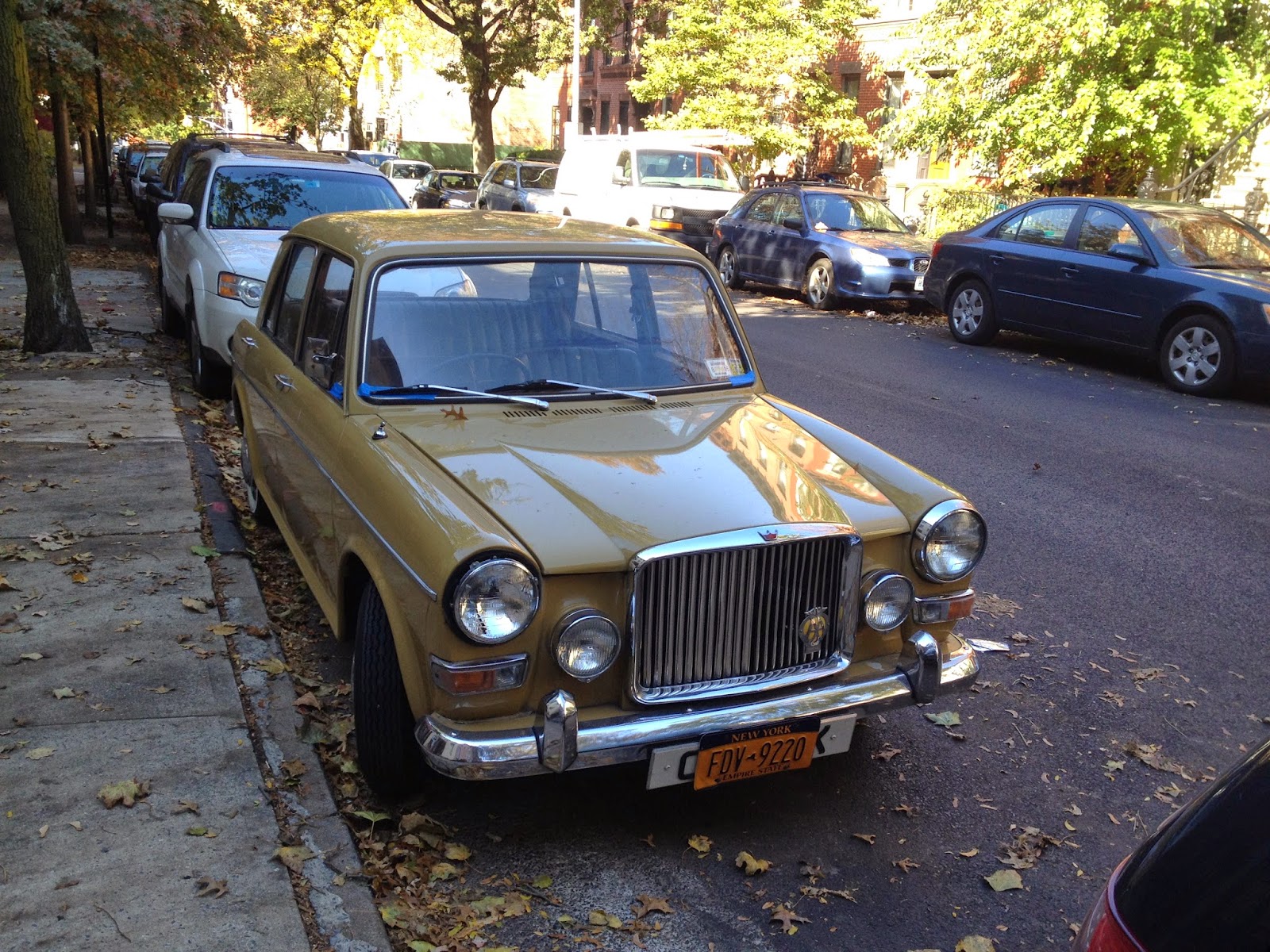STODGY LITTLE BULLDOG
Parked right in front of a friends house in Park Slope the other day was a dour but stately little import the color of autumn leaves (or honey mustard depending how hungry you are).
Yes! This certainly is a rarity in the States as this particular model was never imported. The name of this little crumpet is a multifaceted mouthful; 1972 Austin Vanden Plas Princess 1300.
Austin is the parent company that produced various generations of the Princess for decades. Vanden Plas is the name of a proud and historic British coach builder that would outfit normal cars like the Princess with full amenities befitting the upper class.
This Austin is extremely European in its dimensions. A car like this makes the most sense when navigating the tiny streets of medieval cities. A 1972 Ford of this era would be about as undriveable as a car could be in London.
Here we can see many of the differences between a small British car from '72 and an American compact of the same era. Leather seats, wood dash and trim, and classic round gauges with bright metal surrounds all combine for a very refined feel. This is a right hand drive model of course.
The trunk would be fine for groceries and whatnot but you're not going to fit the family luggage in there.
Oh Austin, you can't win 'em all! It's a mystery to me why the owner chose copper foil and twine for a gas cap replacement which can't be convenient in the slightest when filling up. Maybe it requires an odd size cap that needs to be ordered from the UK? Bizarre, flashy fix for now.
I love that this ride still wears its Euro license plates behind the NY ones. It's almost like this car was plucked right off the streets of London and could be placed back there at a moments notice.
Vanden Plas actually began as a company in Brussels in the 1800s, producing beautifully outfitted horse-drawn carriages. When the automobile was still new they started building custom bodies for the likes of Rolls-Royce and Bentley, almost all of which were designed to be chauffeur driven. Before WWII it was possible to order a ultra-luxury car such as a Rolls-Royce or Deusenberg without a body. You would then arrange for the body-less car to be delivered to the coach builder of your choice. Some of the one-off designs from that era are now among the most valuable cars in the world. By 1972 however Vanden Plas was in its last decde of operation, reduced to dolling up little compacts such as this ride.
This is a very lofty name for such a humble car. In the '20s and '30s the Princess was fit for royalty. The models after this one up through the early '80s are forlorn and unloved donkeys that are held up as examples of how the auto industry lost its way in that era.
1300 is a reference to the 1.3 Liter engine powering this little cruiser.
The color looks to be the original choice of Harvest Gold.
The whitewalls are a little garish, but that downward-sweeping side trim combined with the sloping rear window and roofline gives the impression of sporty motion. I should think that the handling would actually be pretty good on such a small car with the wheels all the way out on the corners.
Again with the British classy touches; individual pull-down writing tables made of wood are set into the seat backs! I've seen these pulled down in other rides and each one has a metal-lined cup holder built in as well. With the magazine pouches below you're doing better than in an airplane if you're sitting int he backseat. The ashtray being mounted down on the driveshaft hump is a bit odd, but I think its indicative of just how small this car is. Roomy it's not.
I'm very fond of this dashboard. Of course you need various switches in a car so why not place them all in one panel as opposed to cluttering the entire cabin. Rolls-Royce and Bentley both had very similar interior looks in this era, further lending an air of class to the Princess.
Such a pompous front end for this little mustard packet!
MG built a car with a front very much like this one called the Magnette ZB or 1100. It too was a Saloon, which is the British term for a 4-door sedan.
I imagine this headlight ring is even tougher to locate than the gas cap.
Every Princess deserves a fancy crown!
One of my favorite parts about researching this car was learning the history behind this badge. It stands for the Automobile Association (double-A as opposed to AAA for America). The Association was founded in 1905 to help drivers avoid speed traps set up by police! They actually had cyclists warning drivers that a cop would be waiting ahead so they could slow down in time. These badges let the cyclist know that the driver deserved the protection of their warnings. They were only produced until 1967 so this one actually predates the car itself.
Well there we have it; a proper British Saloon looking very natty in its own staid fashion. I would absolutely love to go for a drive in this thing, but I would not want to pay for the specialist who would have to repair it or locate parts, so hats off to whomever's taken up the cause. Cheerio!



















No comments:
Post a Comment